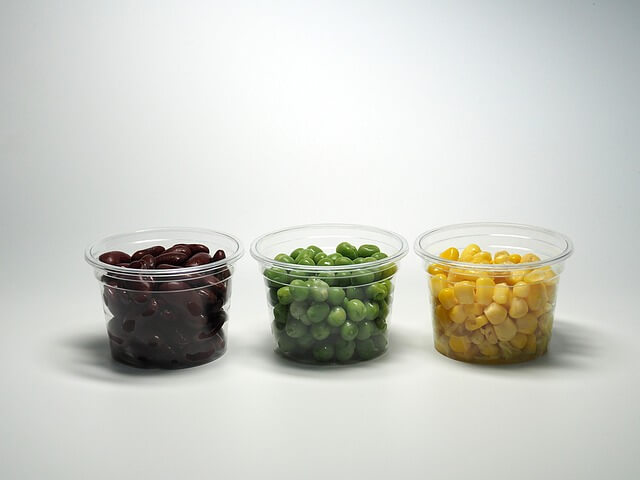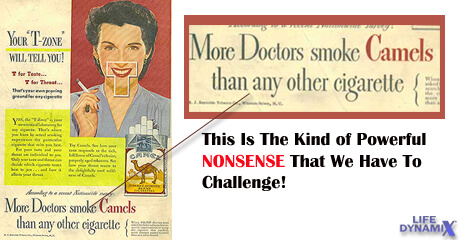The following article was posted in 2005 on our LifeDynamix website warning about the dangers of plastic food containment.
Question: Have plastic food and beverage containers been proven safe?
Answer: No.
During the film’s graduation party in THE GRADUATE, Mr. McGuire pulls Benjamin Braddock (Dustin Hoffman) aside to offer sage advice for his future. His future would be one word: “plastics.”
Of course, we all know Mr. McGuire’s advice and prognostication was correct. Plastics can only be made by man by virtue of his finite wisdom, hence they are patentable. The profit in the manufacture of plastics has been huge. Plastics are everywhere. Plastic manufacturing now uses 4% of the world’s oil production annually. Automobiles are now 9% plastic. It is of my special concern that more foods and beverages are being put into plastic containers. Plastics are ubiquitous now. They persist and accumulate in our ATLAS DRUGGED*, as their production greatly exceeds their chemical degradation rate. Harmful chemicals from plastics are now commonly found in groundwater, waterways, and drinking water.
While standing out in the summer heat in Phoenix, Arizona in 1981, my then girlfriend asked me what was causing the film to form on the inside of the windshield of her new Mazda 626. She said that she had to wipe it off every morning so she could see to drive to work. I didn’t know then. I do now! It was phthalates, the chemical that was added to the plastic dash cover to soften it and prevent cracking. I’m sure by now most of the phthalate has evaporated into our atmosphere and the Mazda is in some junkyard with a cracked up dash.
Phthalates are EDC’s (Endocrine Disrupting Chemicals.) They are chemicals found in recycle codes #1 through #6 plastics. Another EDC (Bisphenol A) is in recycle code #7 plastics. All of these types of plastic EDC’s interfere with the function of sex hormones receptors. In THE GRADUATE Benjamin was quite a stud. I wonder if he’s now taking one of the popular drugs to treat erectile dysfunction, a disorder that has become one of the many epidemics in our new plastic world.
In 2003 a group of Croatian scientists reported that phthalates in plastics dissolved in various solutions. They used a variety of plastic items, including plastic food containers. After 10 days of sitting in distilled water, an average of 55.4 mg/ of phthalates from each kilogram of plastic “migrated” into the water. To a lesser degree the phthalates from plastics dissolved into acetic acid 3% (44.4 mg/kg) and 10% ethyl alcohol (32.3 mg/kg).
The Croatian study shows what Benjamin would suspect if he took chemistry in college: Water is the universal solvent; and it dissolves even the primarily fat-soluble phthalates. The more that you filter water to remove other toxic solutes, the more aggressive water becomes in its power to reach osmolar equilibrium by dissolving its non-inert containers.
What is also obviously missing from the Croatians’ controlled, static testing model are the temperature variations that the plastic bottled water product goes through to get from bottling point to the mouth of the consumer. Transport trucks probably reach a very high temperature in the non-refrigerated cargo areas that carry the typical PETE (recycle code #1 plastic) bottled water in the summer. Heat facilitates the dissolution of phthalates into the water. Then the bottles may be stored for a much longer time than 10 days before consumption. Furthermore, freezing the containers produces micro-fissures in the interior surface of the plastic bottle container as the water expands, exponentially exposing more solute surface area. Traumatic handling or any motion of the package will further enhance diffusion. Applying the laws of physics, all of these factors clearly by extrapolation will increase the water dissolution of the plastic containers.
Fatty foods in plastic containers are even more problematic, as fats are absorbed differently and carry their phthalate solvents into our bodies more easily. Phthalates bioaccumulate because of their fat solubility. Phthalates concentrate on such fat organs in our bodies such as brains, prostates, testicles, ovaries, breasts, and, unfortunately, breast milk. (The other popular food alternatives for infants are worse. Commercial baby formulas are loaded with the manmade phthalates.) I think the worst example of food containment in plastic is milk. All milk except non-fat milk contains fat. Cow milk itself represents a major source of the fats ingested by the public, especially children. Cattle concentrate these chemicals by bioaccumulation because EDC’s from plastics are ubiquitous in water and most animal food sources. Meat and dairy products are therefore a major contributor to this group of human food chain derived toxins, regardless of their containment. It is now irresponsible to add more phthalates to the products by putting the milk products in plastic containers that add MORE EDC’s. Cattle have intentionally been “fattened up” by adding hormones AND unintentionally “fattened up” more by the contamination of cattle food and water by EDC’s. The combination of these chemicals passed on to the consumers in concentrated form in milk products will most likely exacerbate obesity in humans that consume them as well. Our current scientific knowledge and common sense screams for an end to consumer purchase of milk bottled in plastics. Until milk companies have their products quantitatively analyzed for these EDC’s by competent independent laboratories, my strong recommendation is to avoid purchase and consumption of milk and dairy products contained in plastic.
Sadly, the Croatian authors’ 2003 conclusions about the safety of plastics were: “These (exposure) levels would not present a hazard for human health, not even for a prolonged period of time.” However, what was deemed acceptable levels of phthalates in 2003 now is recognized as “crystal clearly” too high.

Selective interpretations from the ACC (American Chemistry Council) lead to this erroneously high level being “set” for past toxicity standards. The ACC is an “industry group” advisor. It’s much like the wolf guarding the henhouse. Thanks to the ACC efforts, control regulations placed upon this chemical class are minimal. An ongoing perpetuation of phthalate approval for use in virtually everything, including containment of food, has resulted. The perpetuation of these mythological high safety standards has resulted in the majority of our food is wrapped or contained in plastics that leach EDC’s into our foods.
The ACC’s Phthalate Esters Panel is made up of representatives from BASF, Eastman Chemical, Exxon-Mobil Chemical, Ferro, and Teknor Apex Corporations. After graduating, Benjamin could have gone to work for any of these companies to share the wealth that plastics manufacturing has reaped, instead of hanging around to sport Mrs. Robinson for the summer!
I love one of the rationalization examples the ACC makes on their PHTHALATES INFORMATION CENTER webpage: “Thanks to phthalates, your nail polish doesn’t chip.” I wonder if they are aware of the “unexplained” high rate of breast cancer in manicurists. I also wonder if they are aware that most breast tissues and breast cancers have sex hormone receptors that are acted upon by the EDC’s found in plastics.
To further confuse the public, the ACC webpage also redefines the PRECAUTIONARY PRINCIPLE which in its un-perverted definition simply is: A (chemical) should not be considered safe until it is proven safe. Environmentalists who are trying to unravel the cause-effect relationships of environmental chemicals, to the otherwise unexplained epidemics of various diseases now affecting man as well as every species on our planet, encourage its application. The ACC’s watered-down version suggests that cost-effective, fearless risks are worth taking.
Can the ACC keep up the phthalate safety illusion forever?
The American Tobacco Association almost got away with it!
See the old tobacco ad below. Hasn’t history taught us anything about toxins?

We now know that EDC’s, like hormones themselves, require very minute amounts to have a physiologic impact. EDC’s are active in parts per trillion! For example, the usual adult maintenance dose of levothyroxine, a drug to completely replace depleted natural thyroid hormone in hypothyroidism, is 1.6 micrograms/Kg/day. Why would I even think about saying that a dose in the milligrams (1000 times as much as a microgram) of a known EDC would be safe, especially for a child or developing fetus?
We now know that phthalates also work in synergy with chemicals in other classes to exert “more than additive” physiologic effects.
Previous experiments in rodents showed that high levels of phthalates interfere with testosterone during gestation resulting in birth defects of the genitalia, testicular cancer, and infertility in the rats.
The ACC inspired acceptable level of phthalate myth should be blown out of the water with a recent study completed by the University of Rochester School of Medicine and Dentistry. This study of 85 human infant boys reported in May 2005 showed that phthalate levels found normally in the general population adversely influenced sexual development. The mothers of these infants had their urine quantitatively analyzed for metabolites of the phthalates. The phthalate exposure these children had correlated with genital abnormalities including smaller penis size and INCOMPLETE TESTICULAR DESENT, which is a condition that greatly increases the risk of testicular cancer if left untreated.
Solution 1 – Choose glass containers over plastic for purchase and storage of food and beverages including milk and water.
American children can consume several milligrams of phthalate each day.
I wonder if THE GRADUATE’S Mr. Robinson noticed that most of the teenage girls now-days have bigger breasts than his seductive wife (gynecomastia), and that they begin thelarche (breast development) and menarche (menstruation) at a significantly younger age, or that many more have an endocrine pathology called PCOS (polycystic ovary syndrome). In my opinion, children’s exposure to phthalates in their environment is the primary cause of recent increases in these phenomena.
The chances of a woman getting breast cancer in her lifetime have probably gone from a risk of less than 1 in 10 (10%) before THE GRADUATE was made to a 1 in about 7.5 (13.2 %) rate today.
The choice to avoid food chain plastics is a “no-brainer” when you understand how these chemicals persist and accumulate in our environment, and how they function in our bodies!
Solution 2 – Choose stainless steel containers over plastic for the storage of food and beverages including water.
Unfortunately, we are past the point of no return with phthalates. Just like cigarettes, I think we’ll have to live as prisoners with their impact on future generations. The only defense we have at this time is to individually choose to avoid them when we can, to mitigate their effects on our health.
Phthalates clearly act upon hormone receptors in both men and women. A concern is the potential phthalate impact on breast and other hormone sensitive tissue in human females, but phthalate’s feminizing potential on males is more of a threat to all species on the planet.
Unlike Mr. McGuire, I think we can choose a better future by avoiding his “one word.” We should start by trying to reduce plastics in our food chain exposures.
Bottom line:
I would strongly advise consumers to purchase beverages and non-solid food products packaged in glass rather than plastic if given the choice.
James A. Ferrel MD, CNC
Comments:
Do you believe in plastic containers that are a “7” or better or would you rather use a glass container, say an Az green Tea container? The public is very confused about this issue.
December 4, 2005, 7:02 am, Harry Snodgrass
Dr. Ferrel’s Response
Dear Harry,
Many environmental medicine physicians do recommend #7 over others (1-6) for water bottles, for example. The fact is both the phthalates (#1-6) and the BPA (#7) are endocrine disrupters. I advise glass or stainless steel over any plastic. Arizona Green Tea has excellent products that I buy in either glass (which has a functional and very attractive outside wrap) or aluminum can. Unfortunately, I recently noticed they are also selling products in plastic containers. I would like to see this very progressive company offer their product sweetened with stevia as an option over high fructose corn syrup and eliminate the plastic container regardless of the plasticizer involved.
December 4, 2005, 4:02 pm, James A. Ferrel M.D. (drferrel@lifedynamix.com)
Addendum posted April 10, 2009
For years I have been warning people about the dangers of plasticizers used in food containment and the similar cover-up emanating from the plastics industry. To appreciate the problem, one needs only to appreciate the sudden, dramatic, and predictable morphology and disease profile changes that have occurred to our species in the last 30 years. Since the debut of The Graduate, we began suffering from epidemics, not of an infectious nature, but of our own making. Although we have not firmly established cause and effect relationships for these scary changes, they are certain to be due to changes in our environment. This is a time frame coincident with plastic food containment proliferation. Plasticizers must be placed on top of the suspect list because it has been established that they migrate from the food containers into our water. Furthermore, they are EDCs. It has long been well established that plasticizers have deleterious effects on animals tested.
Finally, in the Sept. 17, 2008 issue of the prestigious medical journal JAMA the debacle is front and center. The issue’s lead research study article by Iain A. Lang et al concludes that the plasticizer Bisphenol-A (BPA) may be associated with avoidable morbidity in the adult population they studied. Many prior studies had already shown BPA to be an endocrine-disrupting toxin in animal testing, but the FDA seemed unimpressed. The same issue JAMA editorial by Doctors Frederick S. vom Saal and John P. Myers echoes the point I’ve made about the cover-up. “One factor that may be contributing to the refusal of regulatory agencies to take action on BPA in the face of overwhelming evidence of harm . . . .is an aggressive disinformation campaign using techniques (‘manufactured doubt’) first developed by the lead, vinyl, and tobacco industries to challenge the reliability of findings published by independent scientists.” I have seen this same strategy used to defend suspect food chain toxins such as MSG, aspartame, and trans fats.
Now an unbiased study clearly shows significant adverse effects in humans.
The good news is that last month legislators from both the House and Senate introduced legislation to ban BPA from all food and beverage containers.
The bad news is first — it should not have required an ‘act of congress’ to begin to protect the public. The FDA is in place and charged with the responsibility of protecting all food except for meat, poultry, and some egg products, which are regulated by the U.S. Department of Agriculture.
The FDA has a history of being politically and industry influenced. At times it seems to ‘stack the deck’ by forming advisory panels made up of experts with financial ties to industry. These panels consider safety issues. Generally, their approval recommendations are accepted. Just recently the FDA has, to their credit, ‘tightened up’ conflict of interest restrictions for service on FDA advisory committees. However, conflicts persist. Even after the ‘tightening up’, an advisor can have up to a $50,000 financial interest in the companies affected by the committee’s recommendations.
In fairness to the FDA, they are understaffed for such a huge task. It seems reasonable that because their efforts are preventative and that prevention pays large dividends, they should be better funded and staffed. They should have the best equipment for the detection of toxins or suspect toxins at every level of the food chain. Such equipment needs to provide rapid results and handle huge numbers of diverse specimens.
Secondly, the powerful forces resisting public protection remain at work to promote the toxins that continue to poison the public. There is no guarantee that the legislation will pass despite overwhelming evidence of harm. These lobby groups are powerful and legislators have historically been proven vulnerable.
Thirdly, it is too little too late. Phthalates should similarly be banned until they are proven safe. The issue is clear: as a society, we must begin to apply the Precautionary Principle instead of the currently used & reckless GRAS Principle (Generally Regarded As Safe – until proven unsafe).
My advice remains the same (select glass containment over plastic whenever possible) with one additional proviso; read my new book Neogenesis to understand how to best survive and thrive in our increasingly toxic world. It can be viewed free below.





